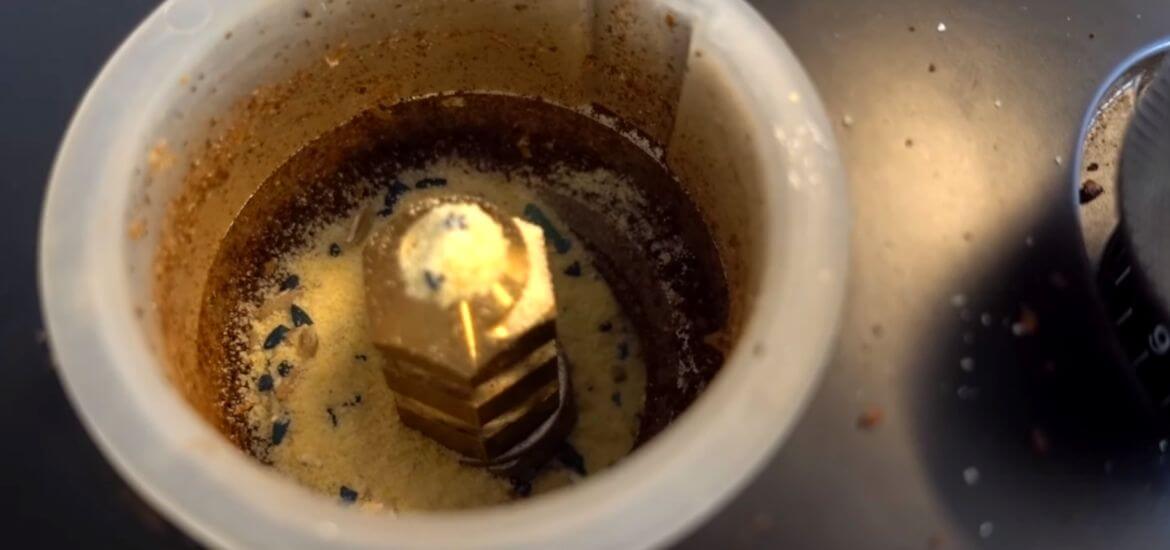A clean coffee grinder is essential for good coffee. Cleaning it is much faster than with an espresso machine . The cleaning procedure shown here can be used with all coffee and espresso grinders. However, the manufacturer's instructions should be followed. For cheaper espresso grinders, different instructions are rarely provided.
In this article, we explain cleaning with cleaning powder. You can also purchase good cleaning powder from us in our shop or from many other roaster or grinder shops.
The new cleaning video linked below also shows how you can clean the grinding discs and the dead space directly and manually with a cloth by opening the grinder.
Remove deposits and coffee oils
As with an espresso machine, it's the coffee oils that build up unpleasant deposits. This is especially true in all the crevices of the grinder, as well as in the bean hopper. The darker the coffee roast, the more oils remain. And oils become rancid under the influence of oxygen. The main goal of cleaning is to remove oils and deposits from the surfaces of the grinding discs and unwanted crevices. After cleaning the grinder, the coffee tastes significantly better, clearer, and cleaner.

Dead space and retention
But oils aren't the only problem. Many grinders have gaps where old coffee can get stuck. This space is called dead space . The coffee grounds are called retention . The coffee is already ground but doesn't leave the grinder. Typical locations include the area in front of the flapper, in the dispensing chute, or around the grinding discs. The flapper's purpose is to remove lumps from the ground coffee, but it can also have a blocking effect.
We distinguish between permanent and temporary dead space . Permanent dead space is filled with ground coffee powder once, but is then no longer replaced with each grinding. Therefore, if the grinder isn't opened and cleaned from time to time, it will age inside the grinder. Temporary dead space contains coffee powder, which is carried out of the grinder during the next grinding.

Clogged coffee behind the flapper of a Quamar M80e.
Why is dead space a problem at all?
The ground coffee sits in the grinder. This exposes it to oxygen and causes it to oxidize more quickly—in other words, it ages faster, tasting different after just 30 minutes and significantly worse after an hour. Unground, the coffee bean itself acts as a protective layer for the coffee. Grinding increases the surface area, which also accelerates aging. Every tiny particle is exposed to oxygen (and possibly light).
The coffee in the temporary dead space is carried out with each new grind. Whether this portion of coffee beans has a significant or significant impact on the flavor depends on the time of the last grind and the size of the dead space. In our extensive test of over 24 home espresso grinders, we therefore focused on examining the dead space.
For example , 2 grams of dead space in a double espresso made with 18 grams of coffee plays a less significant role. If the dead space is 9 grams, half of the espresso will be made with old coffee.
The permanent dead space plays a different role. While the deposited grounds aren't released with each extraction, meaning they don't directly influence the extraction process, they do contain coffee grounds that react with the environment and gradually deteriorate. This impacts the grinder's hygiene. While coffee grounds don't normally mold, they do create a rancid "atmosphere." The freshly ground grounds come into contact with this and literally rub against the old coffee.
Does the coffee in the permanent dead space have a sensory impact? Yes, and it does so significantly! You can do this test yourself. Draw off 18 grams of coffee and then clean the grinder. Follow our video if you have a G-Iota/DF64 or Eureka Mignon. If you have a different grinder, follow the manual, search for a guide on YouTube, or contact us so we can make a video for you. After cleaning, draw off another 18 grams. Now brew two double espressos . Then compare the results.
By the way: the size of the temporary dead space often also affects the consistency of the espresso grinder or coffee grinder. Some shots leave more grounds behind, while subsequent shots dispense more.
The cleaning
- Remove and empty the bean container.
- Grind any remaining beans in the chute. If necessary, replace the bean hopper, as some grinders won't grind properly otherwise.
- Pour a level tablespoon of cleaning powder into the bean chute . Yes, many manufacturers recommend significantly more. But they also want to sell their cleaning powder. We believe a tablespoon is sufficient. In the case of our cleaning powder, that's 10 to 15 grams.
- Grind the cleaning powder.
- Replace the bean container.
- Grind a portion of coffee to remove all traces of the cleaning powder.
You can learn more about this in our coffee courses at www.kaffeemacher.ch/akademie
Frequently asked questions about cleaning coffee and espresso grinders
How often should a coffee grinder be cleaned?
We recommend cleaning the grinder every two weeks. If the grinder is used frequently in a shared apartment or office, the frequency should be increased. In restaurants, we recommend incorporating cleaning twice a week into your cleaning schedule.
Is it necessary to use grinder cleaner when I disassemble and clean the grinder?
Manual cleaning, which involves opening the grinder and removing the coffee grounds in the dead space, is more thorough than cleaning with grinder cleaner. It can therefore be used as an alternative. ![]()


























